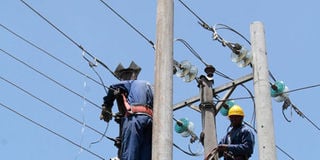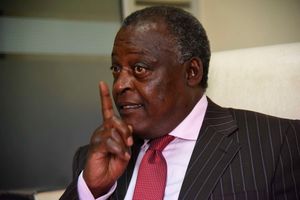
Kenya Power technicians carry out repairs on a transformer. Customers applying for new power connections are hit with high quotations, running into millions of shillings.
Most Kenya Power customers have their own versions of horror stories capturing their painful encounters with the utility firm.
The agonising experiences, most of which are documented on Kenya Power's social media sites, range from month-long delays in reconnecting customers who report power outage to exorbitant monthly bills and recurrent nationwide blackouts.
Customers applying for new connections have also been hit with astronomically high quotations, running into millions of shillings, to buy poles and transformers that become the property of Kenya Power with no plan on how to compensate them for the assets, which are booked in the company's balance sheet.
“At a time like this last year, Sh1,000 would buy me about 51 units of electricity, which would last me nearly a month. Now I get less than 35 units for the same amount,” Catherine Wanjiru, a resident of Nairobi’s Kasarani area, told Nation recently.
“It has greatly affected my electricity usage,” she said, adding: “I sparingly use my instant shower and other gadgets like the washing machine.”
She is not alone.

Power prices have skyrocketed especially over the past year.
Millions of individuals and businesses find themselves in a similar predicament as power prices have skyrocketed especially over the past year, raising the costs of living and doing business.
For instance, a customer in the lifeline tariff, the pro-poor category whose price is subsidised, is currently paying Sh23 per unit of electricity, which is an increase of 15 percent in just 12 months.
Manufacturers, who are the largest power consumers, say their operating costs have skyrocketed due to the surge in electricity prices in recent years.
Their umbrella body, the Kenya Association of Manufacturers (KAM), says power costs have surged by 59 percent in the past three years, from an average of Sh15.8 per unit in January 2021 to Sh25.1 in January 2024.
As a result, says KAM, Kenya is losing its competitive edge as an investment destination in the region as investors flock to Tanzania, Uganda and Ethiopia.
“The economy is emerging from a difficult trilemma (the Covid-19 pandemic, global crises and the 2022 General Election). It is time to support every effort to revamp economic growth. The cost increase is counterproductive,” said KAM Chief Executive Anthony Mwangi.
In an interview with the Nation, Kenya Power Managing Director Joseph Siror defended the company on two grounds. First, he said, the utility firm doesn’t set electricity prices and only collects revenue on behalf of other entities along the value chain.
The Energy Act of 2019 bestows the role of setting electricity prices to the Energy and Petroleum Prices Regulatory Authority (Epra). The agency adjusts electricity prices every month and sets new tariffs every three years. Every six months, Epra also adjusts power prices to cater for changes in the rate of inflation.
“The only component (in the price of power) that Kenya Power is in charge of is operations and maintenance,” said Dr Siror.

Kenya Power Managing Director Joseph Siror when he appeared before the Senate Energy Committee at Parliament Buildings in Nairobi on October 17.
Second, Dr Siror said, many customers are in a position to reduce their power bills by managing the efficiency of their consumption, but they do not.
“Teaching people how to efficiently use power is what we are committed to do and will continue doing,” Dr Siror said.
Manufacturers, however, argue that Kenya Power should improve on reliability and the quality of electricity supply, while reducing both technical and non-technical losses.
Further, the lobby wants the Time of Use (ToU) tariff, which gives customers a cheaper rate for consuming power during off-speak hours, to be restructured to get more industrial customers into the bracket and help improve on capacity utilisation during off peak hours.
The Consumers Federation of Kenya (Cofek) has blamed high electricity prices on the number and level of taxes and levies that are charged on consumers.
The fixed taxes and levies on electricity include the 16 percent Value Added Tax (VAT), five percent Rural Electrification Programme (REP) levy and Epra levy of Sh0.3 per unit.
The variable costs include the inflation adjustment that is reviewed every six months, the fuel cost charge, the foreign exchange rate fluctuation adjustment (Ferfa) and Water Resources Management Authority (Warma) levy.
“We have been having this conversation on the many taxes, levies and variable charges on electricity for a while now. These costs need to be reviewed downwards if we are to achieve cheaper power for consumers,” said Cofek Secretary-General Stephen Mutoro in an interview.

Kenya Power technicians working on a power line.
The Cofek boss questioned the rationale of procuring expensive electricity from Independent Power Producers (IPPs) even during periods when cheaper hydro, wind and geothermal power is available.
Mr Mutoro further called for far-reaching reforms at Kenya Power to address long-standing issues raised by consumers, including estimation of customers' bills and system losses.
There are several reasons why the price of electricity has risen sharply. Between January and March 2023, Kenyans were enjoying the 15 percent tariff reduction put in place by former President Uhuru Kenyatta in January 2022 to lower electricity bills.
That temporary reduction has since lapsed, pushing power prices back up. Consumers are currently being charged each month to recover the losses that Kenya Power incurred as a result of the extension of the tariff cut by President Kenyatta.
In addition, Epra approved new tariffs that took effect on April 1, 2023. The new three-year tariffs led to a sharp increase in power prices across all categories. They will be reviewed in June 2026.
MPs launched a probe into the causes of high power prices and recommended solutions, but a tangible action plan appears to be still out of reach.
A key reason why power remains costly in Kenya is the high capacity charges that are paid to IPPs in the take-or-pay contracts they sign with Kenya Power.
In the two years to June 2022, Kenyans paid Sh15.9 billion for power they never consumed due to the idle power charges, according to a report by Auditor-General Nancy Gathungu.











